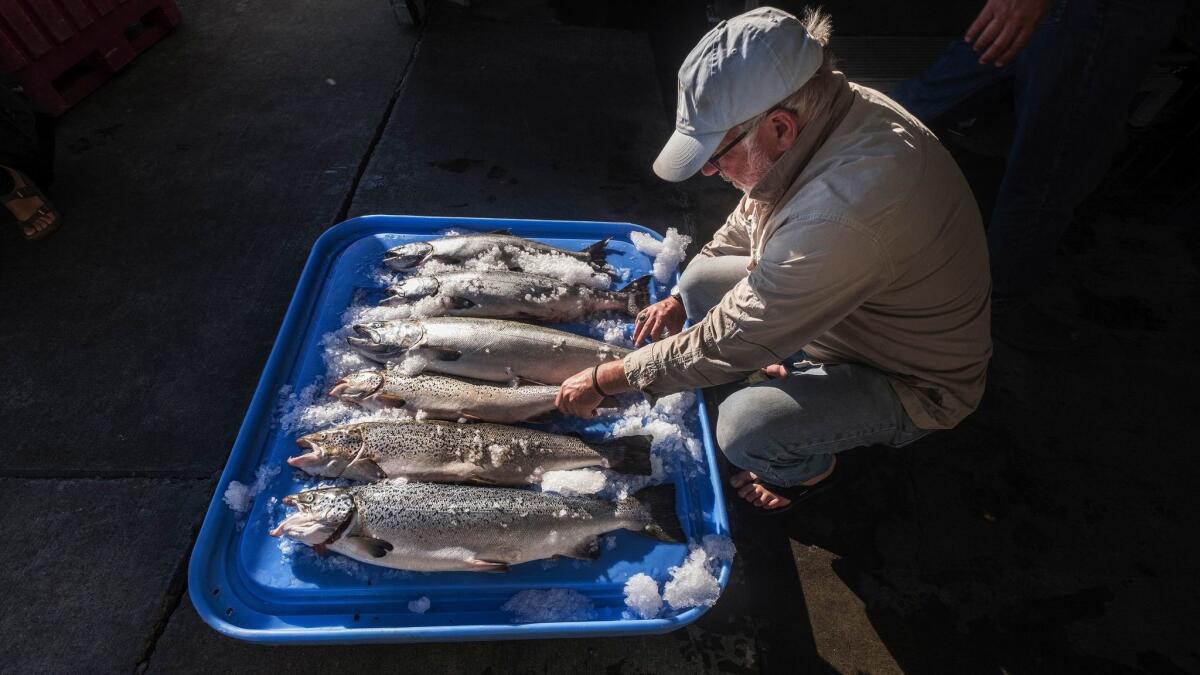More than 160,000 non-native Atlantic salmon escaped into Washington waters in fish farm accident

Reporting from SEATTLE — Documents filed with state regulators show that a fish farm that broke apart Aug. 19 in the San Juan Islands released more than 160,000 farm-raised Atlantic salmon into Washington state waters — far more than the original estimate — and that the holding pen for the fish was “due for complete replacement.”
The Canadian company that operates the farm originally claimed that “several thousand” non-native Atlantics escaped into the Salish Sea, the ecosystem that runs from the Strait of Georgia in British Columbia to the southernmost waters of Puget Sound in Washington state, home of the wild Pacific salmon.
The company also initially said that unusually strong currents, triggered by the moon during the solar eclipse, had caused the pen to break open.
The company, Cooke Aquaculture Pacific, later backed off the linking of the failure to the eclipse. But records filed by the company with the state Department of Natural Resources and the U.S. Army Corps of Engineers indicate that the 30-year-old floating farm’s failure was probably the combination of a strong underwater current winning out over a weakened anchoring system that kept the pen in place.
According to a permit application filed in February by Cooke Aquaculture Pacific in anticipation of replacing the three-pen floating farm off Cypress Island, the system was corroding, rusting and “nearing the end of its serviceable life.”
Cooke, a subsidiary of seafood giant Cooke Aquaculture of Canada, also was planning to reposition the farm “to align it with the prevailing tidal currents at the site.” The fish containment nets, mooring points and net pen structure were under heavy drag loads from the strong Salish currents, the company said.
The accident prompted state and Native tribal officials to declare a fish emergency. They fear the commercially bred, non-native salmon will spread disease and weaken Pacific stocks through crossbreeding.
The state has invited anglers and netters to catch as many Atlantics as they choose, while tribal fishers have been flooding the zone in hopes of lessening the threat of an invasive species in hallowed Pacific salmon feeding grounds.
“Tribal, commercial and recreational fishers continue to recapture fish that escaped the enclosure and Washington’s Department of Fish and Wildlife is collecting data on those catches,” Cooke said in an update Friday.
A company official had no further comment when reached Saturday. As the Times reported Aug. 24, Cooke was aware its pens were vulnerable, stating in a news release that it “applied for permits to allow us to strengthen and update the Cypress site even before the existing fish were harvested out.”
Cooke’s latest numbers show that 142,176 salmon were recently extracted from the damaged and now-empty pen. The other 162,824 of the 305,000 Atlantics went off into the Salish. Some have since been fished out from as far away as coastal Vancouver Island and Seattle.
The fish were about to be harvested from the pen and sold to restaurants or turned into seafood products. Cooke planned to then replace and upgrade the pen farm, starting this month and finishing in December.
Instead, the company is now in the process of sending the recovered fish to a recycling plant and piling the pen’s twisted, rusting remains onto a barge to be hauled away. Cooke purchased the farm and all other entities of Icicle Seafoods of Seattle a year ago for an undisclosed amount.
Cooke’s replacement plan is also on hold while the state completes its investigation into the spill. A planned expansion to another farm Cooke owns on the Strait of Juan de Fuca, one of eight Cooke farm operations in Washington state, remains in limbo as well.
In its Friday update, Cooke officials said that daily water-quality samplings at the spill site north of Anacortes, Wash., “show no adverse effects. Results are being provided to the Unified Incident Command,” consisting of state, tribal and company personnel overseeing the spill aftermath.
When the spill first occurred, there was no mention of the weakened condition of the farm.
As Cooke put it in an initial press release, “exceptionally high tides and currents coinciding with this week’s solar eclipse” led to the escape of “several thousand” Atlantic salmon. After hearing from critics that the farm had withstood even higher tides and stronger flows in recent months, a revised release was issued two days later blaming the tide and current but not the sun or the moon.
The company also issued a revised estimate of the fish that swam away: 5,000, maybe 6,000.
In the February application to replace the farm through a $1.4-million makeover, Cooke officials wrote that “the current condition of the existing fish pen structure can be described as ‘used and nearing the end of serviceable life.’ The existing steel net pen structure has been in service for approximately 16 years in the marine environment and is due for complete replacement.
“Corrosion on the metal walkway grating and substructures is beginning to accelerate. The metal hinge joints in some areas are showing signs of excess wear. Complete replacement of the floating steel net pen structure with a newly manufactured one is considered a ‘best management practice’ for the safe containment of the cultured fish stocks …”
Steel net pen systems in the marine environment are subject to the corrosive effects of salt water and to metal fatigue from the constant wave energy, storms and the “extreme forces” of tidal currents, the company said. Corrosion on the farm’s metal walkway grating and substructures was accelerating, and some metal hinge joints showed signs of excess wear.
“Repairing the rusted steel walkways and replacing fatigued metal components of the existing cage system structure in place,” the company said, “is not cost-effective or practical.”
Anderson is a special correspondent.
ALSO
No longer on a pedestal: New York debates Christopher Columbus statues and the explorer’s legacy
More to Read
Sign up for Essential California
The most important California stories and recommendations in your inbox every morning.
You may occasionally receive promotional content from the Los Angeles Times.










